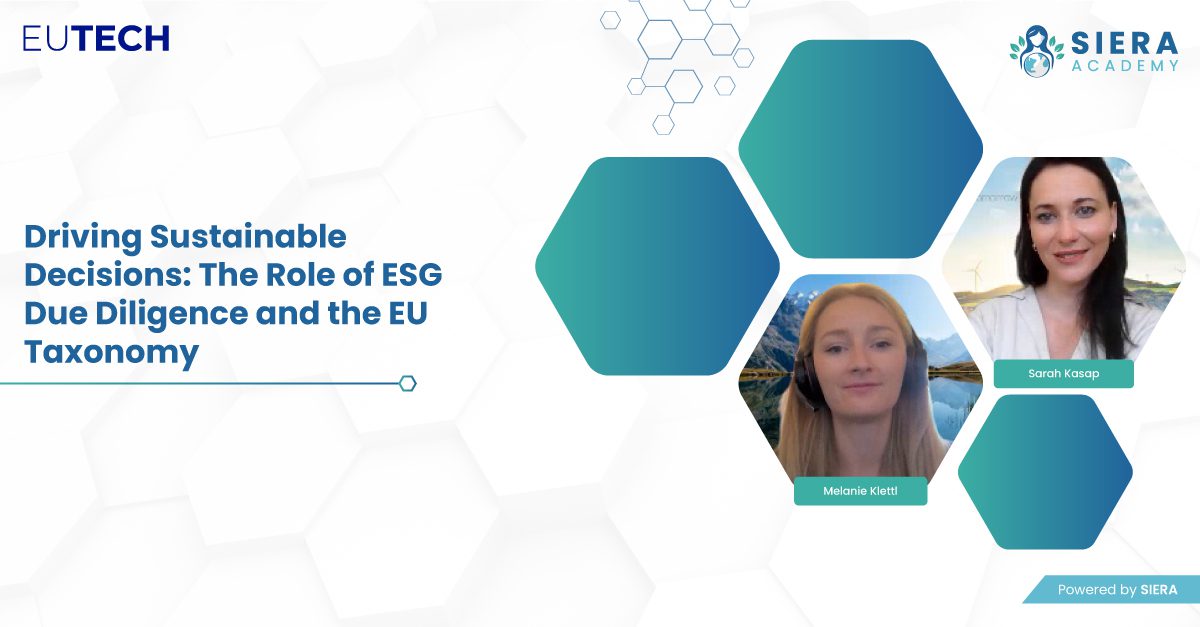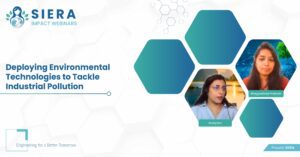As regulatory landscapes shift and the urgency of environmental action intensifies, businesses face mounting pressure to align operations with sustainable practices. On May 8, 2025, the Impact Series by SIERA Academy led an insightful webinar titled “Driving Sustainable Decisions: The Role of ESG Due Diligence and the EU Taxonomy.” This session, led by SIERA Alliance members, business psychologist and sustainable strategy expert, addressed both the complexities and strategic advantages of embedding ESG principles into corporate governance.
The shift from voluntary sustainability practices to mandatory ESG (Environmental, Social, Governance) compliance has accelerated rapidly in recent years. With regulatory frameworks such as the EU Taxonomy, CSRD (Corporate Sustainability Reporting Directive), and CSDDD (Corporate Sustainability Due Diligence Directive) coming into full force, organizations across Europe face both formidable challenges and transformative opportunities.
Understanding the Urgency: Why ESG Compliance is a Business Priority
The European regulatory environment is undergoing profound transformation. New legislation not only requires transparency but enforces accountability. Companies are no longer asked whether they support sustainability—they must now prove it, with standardized, verifiable, and auditable data.
The webinar underscored that ESG due diligence is no longer a siloed responsibility delegated to sustainability teams. Instead, it must be embedded into core business functions—from procurement and finance to strategic planning and investment.
Challenges in ESG Due Diligence and EU Taxonomy Alignment
Participants were presented with a detailed overview of the most pressing challenges companies face when navigating ESG compliance. These are systemic and span technical, regulatory, and organizational domains:
1. Fragmented ESG Data Ecosystems
Data is often dispersed across departments, systems, and suppliers. Manual processes, outdated infrastructure, and inconsistent methodologies compromise data integrity and limit its usefulness for reporting or decision-making.
2. Complexity of EU Taxonomy Criteria
Many companies struggle to map their operations to taxonomy categories due to vague terminology and evolving technical screening requirements. Determining compliance with principles such as “Substantial Contribution” or “Do No Significant Harm” is particularly challenging.
3. Overlapping Frameworks
Businesses must navigate multiple overlapping frameworks—CSRD, SFDR, CSDDD—resulting in duplication of reporting, strained resources, and risk of non-compliance.
4. Lack of ESG Expertise
Most organizations lack internal ESG-trained personnel. Sustainability knowledge is typically isolated within a few departments or outsourced, which leads to disjointed implementation and loss of long-term know-how.
5. SMEs and Resource Constraints
While large companies face stringent requirements, SMEs often lack the capacity to comply. Though the VSME Standard offers a simplified, voluntary pathway, uptake remains limited due to awareness and resourcing gaps.
Regulatory Overview: The New Pillars of EU ESG Governance
The session highlighted how the following regulatory components interlink to form a comprehensive ESG compliance ecosystem in the EU:
| Framework | Purpose | Key Requirements |
| EU Taxonomy | Classifies sustainable economic activities | Disclose alignment with environmental objectives; meet “Substantial Contribution” & “DNSH” criteria |
| CSRD | Expands mandatory ESG reporting to ~50,000 companies | Disclose ESG risks, impacts, and financial implications; adhere to ESRS standards |
| SFDR | Targets financial market participants | Categorizes financial products (Articles 6, 8, 9); mandates ESG disclosures |
| CSDDD | Due diligence directive for human rights and environmental risks | Obligates companies to identify, prevent, mitigate ESG harms in supply chains |
| VSME Standard | Voluntary ESG disclosure for SMEs | Simplified sustainability reporting model tailored for small and medium enterprises |
This shift represents not just a legal evolution—but a paradigm shift in how sustainability is integrated into corporate finance, operations, and governance.
From Burden to Opportunity: Strategic Benefits of ESG Due Diligence and EU Taxonomy Alignment
One of the most transformative insights from the webinar was the reframing of ESG compliance—from a regulatory obligation to a strategic business enabler. Rather than viewing due diligence and taxonomy alignment as cost centers, companies are beginning to unlock direct and indirect value across multiple dimensions.
1. Access to Capital, Sustainable Finance Instruments, and Cost Advantages
The European Union is actively steering capital toward sustainable economic activities through instruments such as green bonds, sustainability-linked loans, and EU-funded grants. Companies that align their operations with the EU Taxonomy can:
- Qualify for preferential lending rates by showcasing alignment with specific environmental objectives such as climate mitigation or biodiversity preservation.
- Demonstrate reduced ESG-related risk exposure, thereby enhancing creditworthiness and lowering the cost of capital.
- Become eligible for participation in public procurement projects that require ESG criteria fulfillment.
- Gain access to EU funding channels including the InvestEU Programme, Horizon Europe, and national green investment schemes, contingent on verified taxonomy-aligned disclosures.
Alignment also positions companies favorably in dialogues with ESG-focused institutional investors who are subject to SFDR obligations, requiring them to disclose the sustainability characteristics of their portfolio holdings.
2. Brand Equity, Stakeholder Trust, and Market Positioning
Companies that effectively integrate ESG principles into core business practices signal transparency, accountability, and long-term thinking. This results in:
- Improved stakeholder relations, including customers, suppliers, partners, and regulators.
- Enhanced visibility in ESG indices, sustainability ratings, and benchmarking platforms (e.g., CDP, DJSI), which are increasingly considered by investors and consumers alike.
- Reputational protection: Proactively addressing ESG issues helps mitigate risks of public scrutiny, media backlash, and accusations of greenwashing—particularly critical in sectors with high environmental or social impact.
- Competitive differentiation in saturated markets, where sustainability credentials are now key criteria in B2B procurement, M&A evaluations, and supply chain partnerships.
3. Catalyzing Innovation and Sustainable Business Model Transformation
The structured requirements of ESG due diligence and EU Taxonomy criteria encourage businesses to reassess legacy systems and innovate across operational, product, and strategic domains:
- Product innovation: Developing low-carbon, resource-efficient products and services that meet taxonomy thresholds fosters alignment with new consumer demands and regulatory preferences.
- Circular economy practices: Emphasis on lifecycle assessment, reusability, and end-of-life strategies drives reductions in environmental impact and operating costs.
- Digital transformation: Adoption of IoT-enabled environmental monitoring and AI-based ESG analytics enables real-time performance insights, predictive risk modeling, and automated compliance tracking.
These innovations not only support ESG alignment but open new revenue streams, especially in emerging sectors like clean energy, sustainable mobility, and regenerative agriculture.
4. Resilience, Long-Term Risk Management, and Value Preservation
By embedding ESG due diligence into enterprise risk management frameworks, organizations are better equipped to:
- Identify and respond to transitional risks, such as policy shifts, carbon pricing, and evolving stakeholder expectations.
- Address physical risks, including extreme weather events, biodiversity loss, and resource scarcity, which can directly impact operations and supply chains.
- Safeguard against supply chain disruptions, particularly where sourcing involves geographies or industries with environmental or human rights concerns.
- Meet upcoming ESG stress testing and scenario analysis expectations from financial regulators, positioning themselves for regulatory readiness and future-proofing.
This proactive risk management approach preserves long-term asset value, protects market position, and enhances investor confidence—particularly relevant in private equity, infrastructure, and manufacturing sectors.
Solutions Framework: From ESG Intent to Organizational Integration
To operationalize the opportunities of ESG due diligence and taxonomy alignment, the webinar outlined a structured five-part solutions framework, emphasizing systemic change over incremental action.
1. Implement Robust, Scalable ESG Data Management Systems
Organizations must move beyond fragmented, spreadsheet-based ESG tracking to centralized, automated platforms that offer:
- Cross-entity data harmonization: Integration of internal data (finance, operations, HR) with external data (suppliers, partners, regulators) through APIs and standardized taxonomies.
- Real-time monitoring of emissions, waste, water use, and social KPIs via IoT sensors and telemetry.
- Audit-ready reporting aligned with CSRD, EU Taxonomy, SFDR, and other frameworks, ensuring transparency and reducing reporting fatigue.
2. Establish Cross-Functional ESG Governance Teams
Compliance cannot be confined to sustainability departments. Cross-departmental ESG steering committees are essential to:
- Align legal, financial, operational, and sustainability objectives.
- Ensure ESG is embedded in capital allocation, procurement, product development, and M&A evaluations.
- Track internal accountability and assign ownership of ESG KPIs to business unit leaders.
Governance teams should be supported by clear policies, escalation protocols, and performance-linked incentives.
3. Leverage External Expertise, Frameworks, and Benchmarks
Given the complexity of evolving EU regulations, external support can accelerate compliance while ensuring accuracy:
- ESG consultants and legal advisors provide interpretations of technical screening criteria, DNHS rules, and minimum social safeguards.
- Frameworks like GRI (Global Reporting Initiative), TCFD (Task Force on Climate-Related Financial Disclosures), and ISSB (International Sustainability Standards Board) serve as best-practice anchors.
- Participation in industry alliances and ESG peer learning groups fosters knowledge exchange, trend identification, and joint initiatives.
4. Invest in ESG Training and Internal Capacity Building
Sustainability must become part of the organizational DNA. This requires:
- ESG literacy programs for all staff levels, from executives to frontline employees.
- Specialized training modules for departments managing finance, procurement, risk, and compliance.
- Continuous education on upcoming frameworks like double materiality assessments and science-based targets.
Internal capacity reduces dependency on external consultants and enables agility in adapting to regulatory updates.
5. Deploy ESG Technologies like SustainSuite
Digital platforms like SustainSuite offer an integrated environment for:
- Automated compliance tracking with CSRD, SFDR, EU Taxonomy, and VSME standards.
- AI-powered ESG optimization to identify performance gaps and recommend remediation strategies.
- Impact monitoring through IoT sensors and real-time dashboards across E1–E5 objectives (climate, pollution, water, biodiversity, resource use).
The platform transforms ESG from a manual reporting burden into a data-driven, strategic management function, fostering long-term resilience and performance.
Case Study: From Fragmentation to Strategic ESG Integration
To demonstrate the practical impact of ESG due diligence and EU Taxonomy alignment, the webinar presented a case study from a European investment firm operating in the infrastructure and renewable energy sectors. Faced with tightening regulations and heightened investor expectations, the firm recognized that traditional ESG assessments—often qualitative and inconsistent—were no longer sufficient.
The Turning Point
The organization initiated a strategic shift in 2022, aiming to embed ESG across all investment processes. The transformation was built around four core actions:
- Systematizing ESG Due Diligence
A standardized framework was developed to assess environmental risks, stakeholder impacts, and governance structures across all deals, ensuring consistent and comparable ESG evaluations. - Applying EU Taxonomy Screening
Every investment was assessed for alignment with the EU’s six environmental objectives, DNSH criteria, and minimum social safeguards. The approach allowed for both full and partial alignment, leveraging flexibility introduced by the Omnibus Directive. - Building Internal ESG Competence
Company-wide training equipped teams with the regulatory knowledge and technical understanding needed to independently evaluate ESG risks and opportunities. - Piloting with a Clean Energy Project
The pilot investment—focused on renewable infrastructure—achieved 58% taxonomy alignment, verified through third-party review. This became the blueprint for broader portfolio integration.
Tangible Results
The transformation led to:
- Earlier ESG risk identification and stronger investment decisions
- Greater investor confidence and easier access to sustainable finance
- Improved readiness for SFDR and upcoming CSRD reporting obligations
- A scalable ESG model now applied across multiple sectors
This case clearly shows how structured ESG due diligence—when aligned with the EU Taxonomy—enhances not just compliance but long-term strategic value and market competitiveness.
Take the Next Step with SIERA
At SIERA Alliance, we help companies transform ESG compliance into measurable performance. With deep expertise in EU Taxonomy alignment, CSRD reporting, and ESG due diligence, we provide integrated solutions that bridge regulatory obligations with strategic business value.
Whether you’re preparing your first sustainability disclosure or optimizing an existing ESG framework, our support extends across compliance, data management, and long-term impact integration.
Our Services Include:
- ESG Due Diligence Frameworks
We design standardized, audit-ready ESG due diligence systems tailored to investment screening, supplier assessments, and corporate strategy—ensuring full alignment with CSDDD, SFDR, and EU Taxonomy. - EU Taxonomy Screening and Disclosure Support
Our experts guide you through technical screening criteria, Substantial Contribution metrics, Do No Significant Harm (DNSH) compliance, and social safeguards for all six environmental objectives. - CSRD and ESRS Reporting Readiness
From double materiality assessments to value chain analysis, we help you meet CSRD disclosure obligations and align with European Sustainability Reporting Standards (ESRS) across E1–E5. - SustainSuite Platform
Our proprietary digital tool enables real-time compliance tracking, ESG performance dashboards, and AI-enhanced reporting—streamlining taxonomy alignment, Scope 1–3 emissions, and CSRD data management. Book a free demo today. - Capacity Building and ESG Governance
We support internal transformation through ESG training, governance models, and cross-functional team integration—embedding sustainability into daily operations and strategic decision-making. - Climate Risk & Resilience Services
Through scenario-based risk modeling, lifecycle impact mapping, and portfolio diagnostics, we help organizations future-proof investments and operations against regulatory, physical, and reputational risk.
Get in touch with SIERA Alliance to unlock ESG insights, accelerate compliance, and drive long-term sustainable transformation. Whether you’re a multinational or an SME, our team is ready to support your transition—from ESG intent to verifiable impact.









